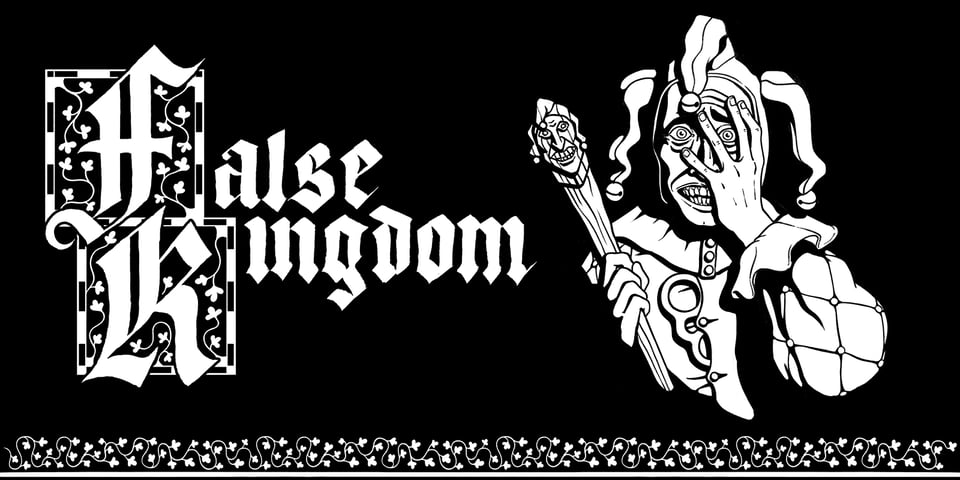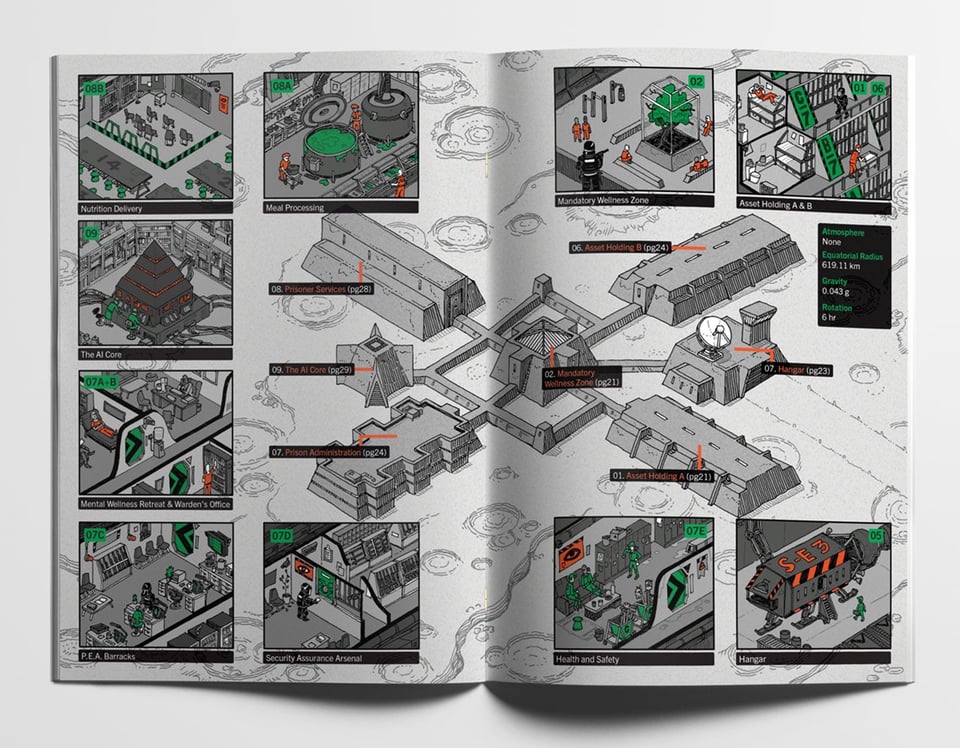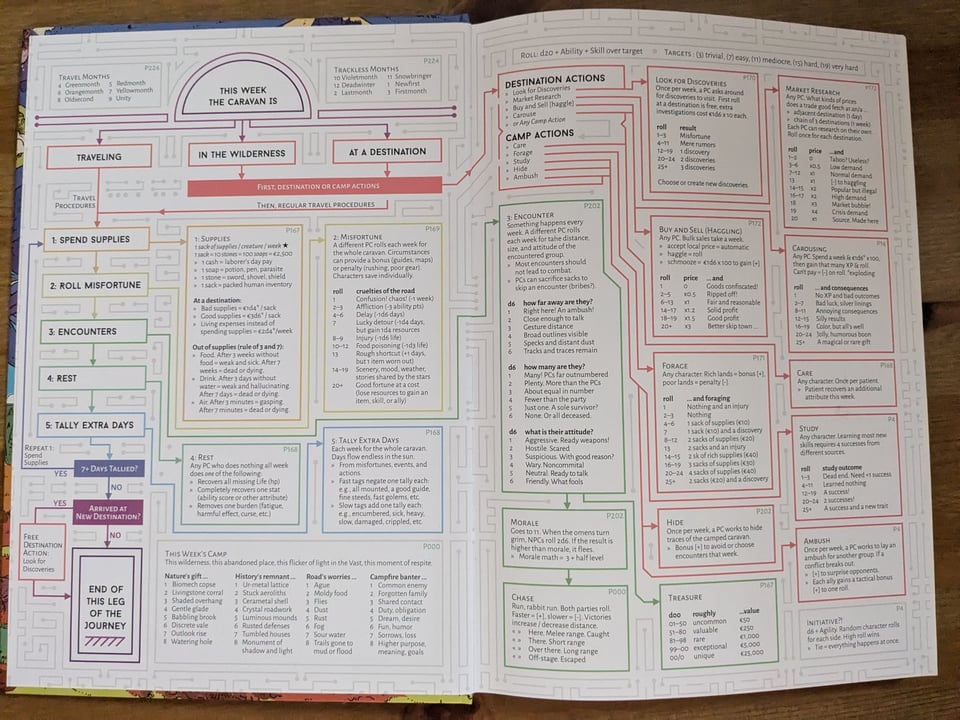Please put your hands together for the ENNIE-nominated designer and layouter, Marsh Davies!
Welcome, weary websurfer, to the TEETH newsletter! This is a now-weekly transmission about our adventures in the very secret land of Tabletop Roleplaying-Games. We have published a whole series of our own TTRPGs! That series is expanding. In this regular publication we also look at other RPGs, play stuff, interview people. It’s a whole lot of newsletter.
What’s within is written and compiled by handsome accident, Jim Rossignol, and distracting deliberation, Marsh Davies. Come and join us over on the TEETH Discord! Free tooth emojis for everyone.
And hey, if you can wish to support us and also get a fantastic 320-page RPG, you can BUY OUR BOOK. If your aren’t already a member of that very cool and very exclusive club. Perhaps you are.

OUR LATEST (AND FREE) PUBLICATION: FALSE KINGDOM, a grotesquely comic role-playing game for 3-5 players in which a group of conniving courtiers attempt to survive a bloody succession crisis in a cursed corner of 12th-century England.
If you enjoy this newsletter you can tip us by picking up this Pay What You Want RPG and donating a few dollars as you do so.
CONTENTS
Hello, you.
Links!
A Reading Of Ultraviolet Grasslands and The Black City: Second Edition
Hello, you.

Yes, it’s certainly an up week around here, as we discovered Marsh was ENNIE nominated for the design and layout of the TEETH RPG book! A well deserved nomination, I am sure you will agree, for there is no better way for us to get people’s attention for our work than by showing them some pages from our prodigious tome.

And there’s more to come on that count: our second book is well underway, and there will be much news about that to come in the next few weeks.
But hey, listen, if you’re enjoying our games, or want to ask questions about them, or just fancy a chat about beholders, then why not swing by the Discord? It’s quiet, but no one will bite! How could they? It’s an internet chat room.
Oh, also: the newer stuff - TEETH, False Kingdom, More Teeth - is all now up on DriveThruRPG, if that’s your bag. Or, indeed, the bag of anyone else who might be interested.
Love,
-Marsh & Jim
LINKS
THING OF THE WEEK: It feels a little like we’re developing a theme here with our Thing of The Week having a literary reference? Brian Catling and Umberto Eco last week for Rosewood Abbey, and Invisible Cities this week for A Traveller In The City. This is a free-to-download collaborative storytelling game with a minimal sort of complexity and a simply beautiful presentation. If these kinds of game are your jam, as they are ours, then it’s worth acknowledging that they’re built using the Carta system for making solo RPGs. Go have a nose around!
Regular readers will recall that we’re big fans of Guy Pradel’s work, and I had previously missed that he illustrated a Mothership adventure, The Cleaning of Prison Station Echo. I mean, look at that.

There are a couple of big bundles up this week, with a veritable library of Runequest stuff. (Which, frankly, gives me the fear, but will doubtless be drawing someone in.)
But also the renewed Bundle Of Holding for Fading Suns, a game that I have enormous fondness for due to owning the 1995 softcover. I have a bunch of games from that era which won’t be likely to make it to the table thirty years on, and this is probably the least likely, despite my love of its particular baroque mode of play and world-building.
Finally, not an RPG, but Quiet: Level One is a forthcoming graphic novel from videogame concept lead of legend, Jonah Lobe, starring a cute skeleton. I suspect it will have some fans around here.
A Reading Of Ultraviolet Grasslands and The Black City: Second Edition
I casually mentioned over on the Discord that I might give UVG:2E (UK stock) a quick read-write up, and so here it is. To be clear: we’ve not run this as at the table, but I always read more books than we have time to run games, and so I feel it’s absolutely okay to spend some time talking about that first part. The reading of books, I mean.

There is no serious shortage of evocative, attention-capturing titles in the world of tabletop games, but Ultraviolet Grasslands and The Black City: Second Edition is surely one of the top-tier contenders. First impressions are powerful things, and this book has those in spades. The cover depicts a giant gelatinous pink sphere releasing a tentacular wave-cloud of birds and fish into the sky as weirdo travellers calmly stand around near their buses and astro-helmeted camel-robots, as if the vibe is psychedelic tourism. Read any further and you will quickly realise: that is absolutely the vibe.
How could I not investigate such an artefact further?
How could I not settle in for a read of this on the basis of the ‘70s prog rock album title alone? And how could I not get hold of a copy of a book which reeks of continental comic books of the last century and swims with the broadening school of art that now follows in the wake of the great master of that time, Moebius himself?
There is no way, for me, not to read a book which promises “a fantascience adventure designed to take the PCs on a long strange trip across a mythic steppe filled with remnants of space time and distorted riffs”? Yes, friend, the tropes that are being evoked here are worn openly on its pastel rainbow sleeve and they’re ones I have talked about for a long time.
I have to say at this point that I am a newcomer to UVG, and so unlike Wyrd Science’s recent review in Issue 5, I can’t compare what I find here to the earlier edition. I am therefore not able to contrast what I read with the philosophical, nebulous-sounding first pass on this world, with its elided rules and recursive crypticism. What I find instead is a game in which the rules are summarised on a single page, and where the procedure -- for procedure is at the heart of this thing -- is summarised on by two colourful, but enormously dense, flow diagrams.

And to be clear, I love this. I love it all. Procedural games with simple rules that leave broad space for narrative invention now lie at the centre of my interests. That said, both the native rules for this game, and the flow diagrams, produced an ambivalent, perhaps uncomfortable, feeling in me that we’ll return to in the conclusion. Hmm!
The structure of UVG is one I particularly like: a long, node-based map linking together a series of locations that can be explored in their own right. Your cast of wild-sounding word-salad characters -- “Volkan diesel dwarf barista,” “Ashen deserter from the flower war,” and so on -- make up a caravan whose resource-management and misfortunes will define much of what happens to the characters on their great journey. Their choices about where to go, and what actions to perform when they get there, will make the rest.
Risking a “getting a lot of Boss Baby vibes” fallacy, I can’t help contrasting UVG with the previous node-based map game that I played a full campaign of, which was Band Of Blades. Our game of BoB was somewhat skewed by the fact that we felt a sense of urgency to get across the map, while not realising that actually we needed to stick around the various locations to shore up our campaign-concluding defence of the final citadel. UVG has absolutely the opposite problem: you are invited to stick around and explore the weird shit until you get bored or lose the thread. This is a psychedelic journey, and one that there are few reasons not to take your time with.

UVG is a journey across a landscape in which the players will encounter bio-metallic tumour trees, and parasitic charcoal fetishes, not to mention migrating grass colonies “shot through with vampire varietals” or perhaps even grubby itinerant chitin foragers. Working out what most of these things are or do is really up to the GM, as they’re generally given a name, a level, and a behaviour, and little else. There’s a great deal here, but it’s invoked impressionistically, as if from a great distance. Additionally, this is not an inherently dangerous landscape, NPCs know things, and have an attitude, but they aren’t necessarily enemies, despite some of the many, many random encounters being weird and dangerous. Which is fine! But it does mean you need to work out what things are for. It is sweet and heady, and best imbibed patiently, like hallucinogenic mead.
And that structure is really what drives the entire home for me. Having possible locations you might travel to, having choices at forks in the road, this all reinforces my feeling that a node-based road trip is a really fantastic structure for a game. There’s a linearity to it, but nevertheless it’s a wide corridor. A road is an excellent thing to hang a game on, because it gives you somewhere to come back to, even when you stray off it to explore, and a clear direction to be headed. It also -- with your caravan and its animals/vehicles in UVG -- gives you a sort of mobile base to think about. That’s got some real crunch to all this, and I love the possibilities it suggests. (One of my go-to target ideals as a game designer has long been the Highway 17 section of Half-Life 2. Those bits where you can park up the buggy to go and investigate some abandoned house on a clifftop? Hell, I’ve never made a game, digital or tabletop, that really hits those notes, but jesus christ I mean to. UVG provides so much “cool mysterious thing visible in the distance” material for this that I feel like I am being massively personally indulged by its very existence.)
Anyway, that feeling that I mentioned back in the seventh paragraph? Well, like much of UVG, it’s just a vibes thing, and it’s this: there is a sense here that UVG would take me, as a GM, serious work to get to the table. And serious work at the table. Many of the descriptions of people, things, creatures, and locations are hugely poetic and beautiful, evocative and eerie. There’s a lot of language here. But there’s a clear challenge to a GM to do the heavy-lifting to transform those colourful strings into the meat and skeleton of a coherent campaign.
UVG is incredibly rich in Hooks -- those scenes, people, and events which get players intrigued and interested -- but I feel like it lacks something else, let’s call them Anchors, which would keep the player’s attention long term between those nodes of the stark, minimalistic diagram of a map. And maybe it would be okay just to see and interact with the weird stuff that’s out there. Perhaps it could just be tourism. And perhaps the procedure of keeping the caravan from misfortune would be drama enough to keep everyone’s attention at the table. But it makes me wary. I need to see more anchors.
Hooks and Anchors. That totally sounds like the sort of RPG theory essay someone would write, right?
So yeah, anyway, I think I personally would happily wander in an improvised meander through these strange gardens of thought, but at the same time I wonder whether my players would buy in without the pressure and drama that other game setups provide. I personally adore watching psychedelic movies in which nothing really happens, for example, but it’s hard to recommend them to other people. I think that’s what I’d be selling here. Experience tells me that’s hard work to get people on board for the requisite amount of time and attention you need to traverse a psychedelic steppeland.
Given this is such a chill game with this phantasmagorical setting, that idea that it might be really hard work feels almost contradictory. But it is a feeling, and probably a subjective response based on past experiences with other games. Perhaps it’s fine! I haven’t run it, as I said. People with more intimate experience of this system and lots of table time tell me it’s an experience, and I believe them.
And, all that said, I would also be tempted to run another ruleset, as the game itself suggests one might. I like thin and simple rulesets, but I wasn’t particularly taken with this one.
To be clear: I adore this book. Its creator (both artist and author) is a sorcerer of an order I can only aspire to. I have marvelled at this book for hours as I sat in my old reading chair by the big window. The love and work that has been poured into this book effervesce from it into the real world: it enriches the universe with its very existence. And there’s something sacred about such projects finding their way into our hands. I will often reach for this book on my shelf. It is a treasure. Whether I can also make the jump through the portal to actually get it to the table, however, I am less certain. Perhaps that doesn’t matter. The hobby is, after all, as much about the books themselves, as it is the games we play with them. That, after all these years, is my absolute belief, and UVG:2E serves, quite profoundly, to reinforce that.
-jim
More soon! x
Add a comment: